If your begonias are dying, it’s important to figure out why so you can save the rest of your plants. This article will discuss some of the most common reasons begonias die, as well as some solutions.
How to Know If your Begonia Is Dying
There are a few possible reasons for this: too much or too little water, not enough light, or pests. If your begonia’s leaves are wilting, yellowing, or browning, it’s a sign that your plant is not doing well.
If the leaves are still wilting, try moving the plant to a spot with more or less light. If you think your begonia is getting too much or too little water, the best way to fix the problem is to let the soil dry out completely or water it thoroughly until water runs out of the bottom of the pot.
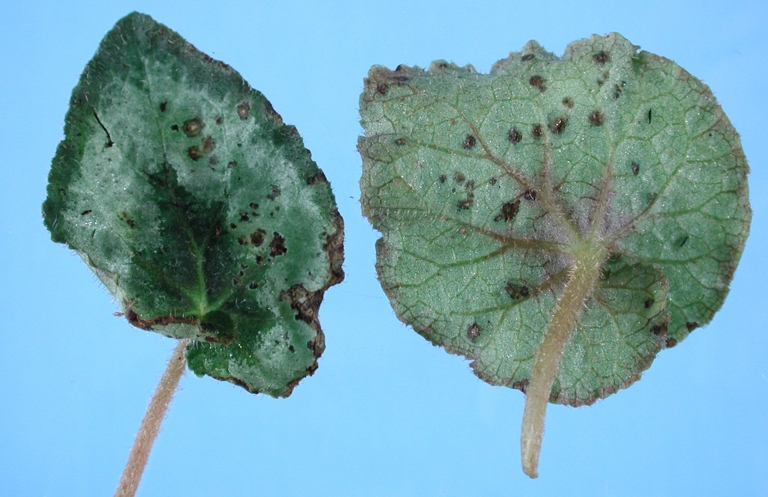
Try fertilizing it with a Begonia-specific fertilizer or a general-purpose fertilizer. If you don’t see any pests, but the leaves are still yellowing or browning, it’s likely that the plant is not getting enough nutrients.
Rotten or Dried Up Roots
If your begonias have rotten or dried up roots, it’s likely because they’re not getting enough water. The first step is to check the soil to see if it’s dry. If the roots are still rotten or dried up, you may need to replant them in fresh soil. If it is, water your begonias deeply and wait a few days to see if they recover.
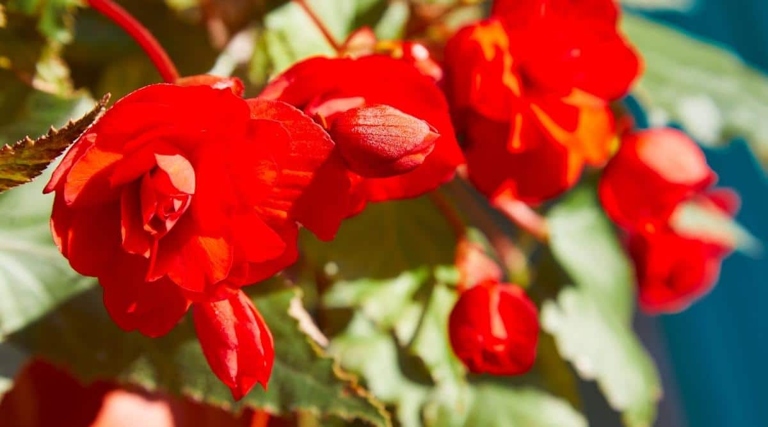
To prevent root rot, make sure to water your begonias regularly and never let the soil dry out completely. If the roots are truly rotten, the plant will eventually die. If you live in an area with high humidity, make sure to plant your begonias in well-draining soil to prevent the roots from sitting in water. If you think your begonias’ roots are rotting, look for other signs of stress, such as wilting leaves or stems.
Yellowing of the leaves
One of the most common problems with begonias is yellowing of the leaves. This can be caused by a number of factors, including too much sun, too much water, or a lack of nutrients.

If the leaves of your begonia are turning yellow, it’s important to figure out the cause so that you can take steps to remedy the situation. If the problem is too much sun, try moving your plant to a shadier spot. And if the problem is a lack of nutrients, fertilize your plant with a balanced fertilizer. If the problem is too much water, allow the soil to dry out before watering again.
Browning of the Leaves
This is a normal, annual event for many plants, but it can be alarming if you’re not expecting it. As the weather cools and days grow shorter, many plants begin to prepare for winter by undergoing a process called senescence. During senescence, leaves may change color and drop off the plant.
If you’re wondering why your begonias are dying, it’s likely due to senescence. Browning of the leaves is one of the first signs that a plant is beginning to senesce. This is perfectly normal and there’s no need to be alarmed. As begonias enter senescence, their leaves will gradually turn brown and drop off the plant.
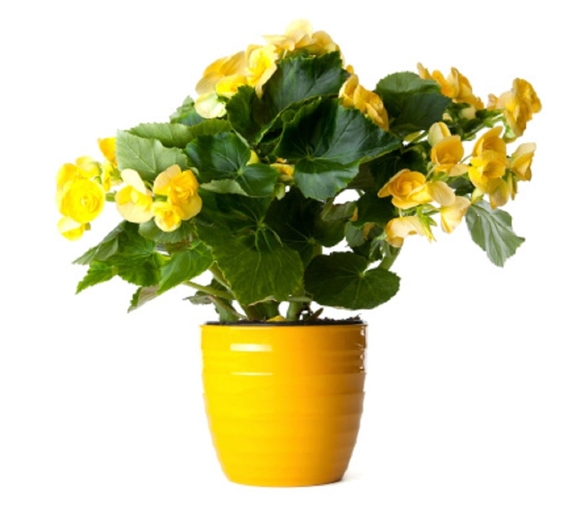
Once all the leaves have fallen off, your begonia will enter dormancy and will need very little care until spring. This won’t stop the senescence process, but it can help your plant look neater. If you want to keep your begonias looking their best during senescence, you can try trimming off the brown leaves as they appear.
Drooping Leaves
One of the most common problems with begonias is drooping leaves. This can be caused by a number of factors, including too much water, too little water, or even a lack of nutrients.
If it’s too dry, the plant will need more water. If your begonia’s leaves are drooping, the first thing you should do is check the soil. If it’s too wet, the roots may be suffocating and the plant will need to be watered less frequently.
If your plant is not getting enough of these nutrients, the leaves will start to droop. Another possible cause of drooping leaves is a lack of nutrients. Begonias need a balanced fertilizer that contains both nitrogen and phosphorus.

If the problem is too much water, you can try moving the plant to a drier location. If you’re not sure what’s causing your begonia’s leaves to droop, you can try misting the plant with water. This will help if the problem is too little water.
Presence of Powdery Mildew or Feathery Growth
These are signs that your plant is under stress and is not getting the nutrients it needs. If your begonias have powdery mildew or feathery growth, it’s important to take action immediately.
It is caused by a lack of moisture in the air. Feathery growth is a white, fluffy growth that forms on the stems and leaves of your plant. Powdery mildew is a white powder that forms on the leaves of your plant. It is caused by a lack of nutrients in the soil.
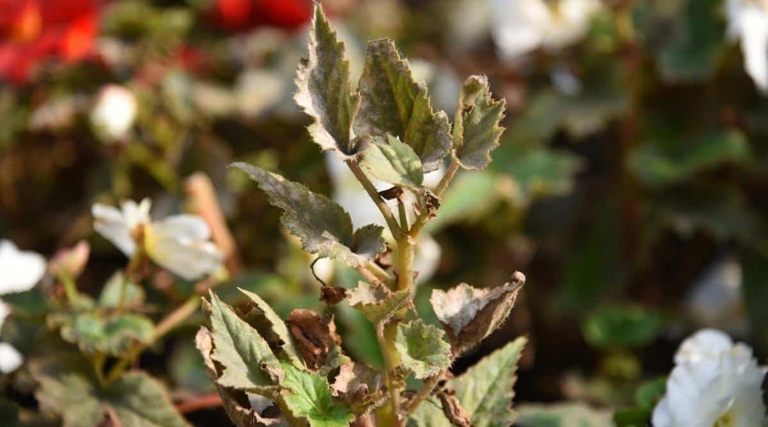
To fix these problems, you need to water your begonias more frequently and fertilize them more often. If these problems persist, you may need to consult a professional. You should also make sure that they are getting enough sunlight.
Brown Dots or Holes in Leaves
Begonias with leaf spot should be removed from the garden to prevent the disease from spreading. This disease is most common in humid or wet conditions, so it’s important to water your begonias only when the soil is dry. If you notice brown dots or holes in the leaves of your begonias, it’s likely due to a fungal disease called begonia leaf spot.
Stunted Growth and Curled Leaves
In this case, you should consult a professional. If your begonias are displaying stunted growth and curled leaves, it is likely due to a lack of water or nutrients. If the problem persists, it may be due to a pest infestation or disease. Make sure to water your begonias regularly, and fertilize them every few weeks.
Symptoms and Treatments for Dying Begonias
If the problem persists, you may need to replant your begonias in fresh soil. Some common symptoms of dying begonias include wilting leaves, yellowing leaves, and brown spots on the leaves. If your begonias are displaying these symptoms, you may need to provide them with additional water or fertilizer. If your begonias are dying, it’s important to identify the symptoms so you can determine the best course of treatment.
Begonias Diseases
There are a number of diseases that can affect begonias, including powdery mildew, root rot, and leaf spot. Each of these diseases can cause serious problems for your plant, so it’s important to be on the lookout for signs of trouble.
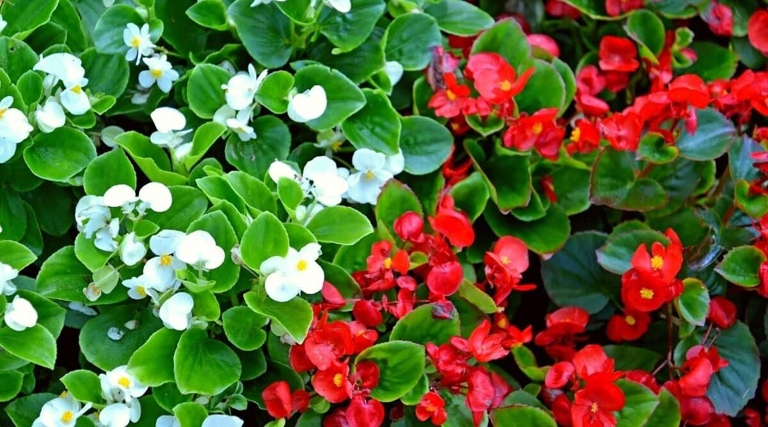
This disease can spread quickly, so it’s important to take action as soon as you see it. Leaf spot is a bacterial disease that causes brown or black spots on the leaves of your plant. This disease can also spread quickly, so it’s important to take action as soon as you see it. Powdery mildew is a fungal disease that manifests as a white, powdery growth on the leaves of your plant. This disease causes the roots of your plant to rot, which can lead to the plant dying. Root rot is another fungal disease that can be devastating to begonias.
If you think your begonia has any of these diseases, it’s important to take action immediately. These diseases can spread quickly and kill your plant if left untreated.
Bacterial Leaf Spot and Blight
Both of these diseases are caused by bacteria, and they can quickly kill a begonia plant if left untreated. Bacterial leaf spot and blight are two of the most common problems that can affect begonias.

Bacterial leaf spot is characterized by small, dark spots that appear on the leaves of the plant. The spots may eventually turn yellow or brown, and the leaves may eventually drop off.
Blight is a bit different, and it usually affects the stems and leaves of the plant. The stems may turn black and the leaves may wilt and die.
If you wait too long, the plant may not be able to be saved. Both diseases can be treated with a fungicide, but it’s important to catch them early. If you think your begonia has either of these diseases, it’s important to act quickly.
Pythium Rot
This fungus can be controlled by using a fungicide. Pythium rot is a disease that can affect begonias. The symptoms of this disease include wilting leaves, yellowing leaves, and stunted growth. The disease is caused by a fungus that lives in the soil and attacks the roots of the plant.
Rhizoctonia Crown Rot
The lesions may be covered in a white, fuzzy mold. Rhizoctonia Crown Rot is a fungal disease that affects begonias. The disease is most common in wet, humid conditions. The fungus can also infect other plants in the begonia family, such as impatiens and wax begonias. The disease is characterized by brown or black lesions on the stem and leaves of the plant. The disease is caused by a fungus called Rhizoctonia solani. The fungus lives in the soil and infects the plant through the roots.
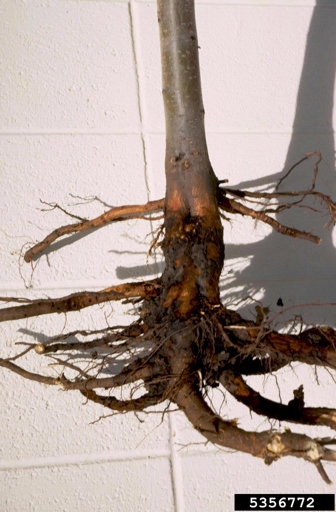
Water the plant at the base, rather than from above. Apply a fungicide to the plant, following the directions on the label. To control the disease, it is important to keep the plant’s leaves dry. Destroy the infected plant material to prevent the fungus from spreading. If the plant is already infected, remove any affected leaves and stems. Avoid overhead watering, which can spread the fungus.
Save Begonias from Diseases
If your begonias are dying, it could be due to one of several diseases. Here are some signs to look for, as well as some solutions.
It can spread quickly, so it’s important to take action as soon as you see it. This disease appears as white, powdery spots on the leaves. To treat powdery mildew, you can use a fungicide. One disease that can affect begonias is powdery mildew.

This disease is caused by too much water. To prevent root rot, make sure you’re not overwatering your begonias. The roots of the plant start to rot, and the plant eventually dies. Let the soil dry out between waterings. Another disease that can affect begonias is root rot.
If your begonias are dying, it’s important to take action to save them. By identifying the disease and taking steps to treat it, you can keep your begonias healthy and thriving.
How to Cure Bacterial Leaf Spot and Blight
Bacterial leaf spot and blight are two of the most common problems that begonia growers face. Both can be caused by a number of different bacteria, but the most common are Pseudomonas and Xanthomonas. There are a number of ways to control these diseases, but the most important thing is to prevent them from getting a foothold in the first place.

It’s also important to remove any infected leaves as soon as you see them. Watering from above can splash the bacteria onto the leaves, where they can start to infect the plant. The best way to prevent bacterial leaf spot and blight is to water your begonias from below. This will help to prevent the disease from spreading.
If your begonias are already infected, you can try treating them with a copper-based fungicide. This will help to kill the bacteria and stop the disease from spreading. You can also try using a bactericide, but these can be hard to find and are often quite expensive.
Whatever method you choose, it’s important to be patient. Bacterial leaf spot and blight can be difficult to control, but with perseverance, you should be able to get your begonias back to good health.
Stopping the Spread: Cut out the Infected
This will help to prevent the spread of the disease to other plants. If you think your begonias might be infected with a disease, the best course of action is to remove the affected plant from your garden.
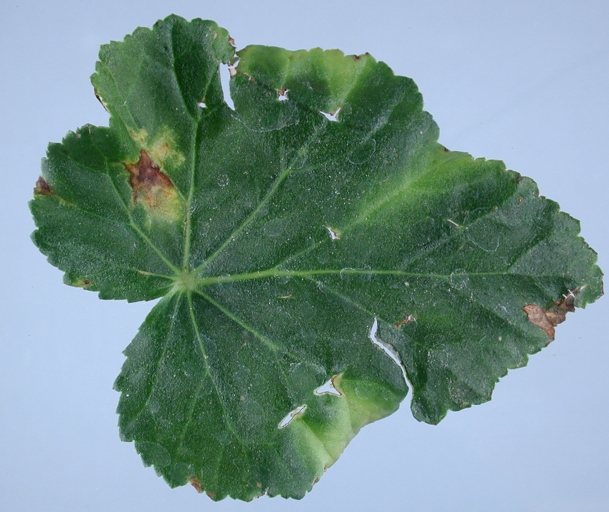
If the plant is heavily infected, you may need to remove the entire plant. This will help to prevent the spread of the disease to other plants. If you have begonias that are showing signs of disease, the first thing you should do is isolate the affected plant. Once you have isolated the plant, you will need to remove all of the diseased leaves.
You can disinfect your tools by soaking them in a solution of bleach and water. This will help to prevent the spread of the disease to other plants. Once you have removed the affected plant, you will need to disinfect your gardening tools.
By taking these steps, you can help to prevent the spread of disease in your begonia plants.
Prevent Survival
There are a few things you can do to prevent begonia death: If your begonias are dying, it’s important to take action to prevent further loss.
Check the plant’s water needs and make sure it’s getting enough water. 1. Begonias are sensitive to drought and will wilt quickly if they don’t have enough water.
Begonias are susceptible to a number of problems, including root rot, leaf spot, and powdery mildew. Inspect the plant for pests or diseases. Treating the problem early can help prevent further damage. 2.
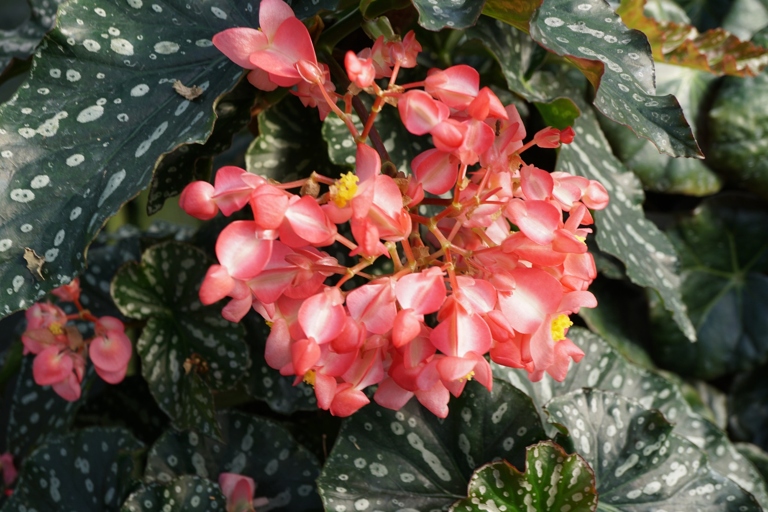
Make sure the plant is getting enough light. If your plant is in too much shade, it may start to die. 3. Begonias need bright, indirect light to thrive.
Begonias need a steady supply of nutrients to stay healthy. Fertilizing every two weeks should be sufficient. 4. fertilize regularly.
By following these tips, you can help prevent your begonias from dying.
Copper spray or Oxidate
Black spot is a common problem in begonias and can be treated with a fungicide. If your begonias are not getting enough copper, they may start to show signs of yellowing leaves, stunted growth, and eventually death. Another possibility is that they are being attacked by a fungal disease called “black spot.” Copper is an essential nutrient for begonias, and it can be applied as a spray or in the form of a fertilizer. If you think your begonias are dying from a lack of copper or from black spot, be sure to take action quickly in order to save them. One possibility is that they are not getting enough copper. If your begonias are dying, it could be due to a number of reasons.
Activator spray
Simply follow the instructions on the package and apply the spray to your begonias. You may need to apply the spray multiple times to see results. If your begonias are dying, one possible solution is to use an activator spray. This type of spray helps to promote plant growth and can be found at most garden stores.
Biological Chemical Treatment
Begonias need to be kept moist, but not wet. Allow the top of the soil to dry out slightly between watering. Finally, begonias are susceptible to a number of pests and diseases. Begonias need bright, indirect light. Another possibility is that they are not getting enough light. If they are getting too much direct sun, they will sunburn. If you see any signs of pests or diseases, treat them immediately. One possibility is that they are not getting enough water. If your begonias are dying, it could be due to a number of reasons.
How to Cure Pythium Rot
Pythium rot is a serious problem for begonias, and can often be the cause of death for these plants. There are several ways to treat and prevent pythium rot, but it is important to act quickly if you think your plant has this disease.
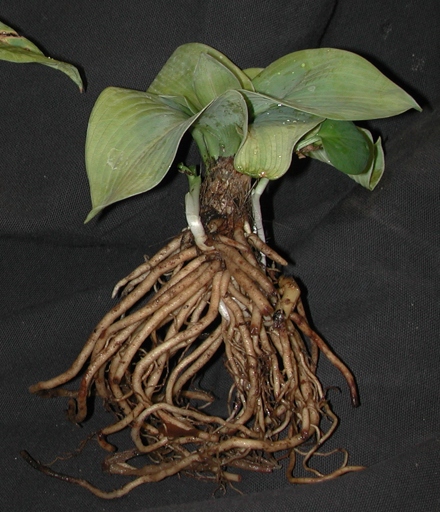
You can also try using a fungicide to treat the plant, but this should be done as a last resort. One way to treat pythium rot is to remove the affected leaves and stems from the plant. This will help to prevent the spread of the disease to other parts of the plant.
You should also avoid overcrowding your plants, as this can make it easier for the disease to spread. To prevent pythium rot, it is important to water your begonias regularly and to make sure that the soil is well-drained.
Prevent Overwatering Begonia
If you’re still having problems with overwatering, consider planting your begonias in self-watering pots. To prevent overwatering, water your begonias only when the top inch of soil is dry. While begonias need to be kept moist, they don’t tolerate soggy soil. Allow the water to seep down to the roots, and then empty any excess water from the saucer. If you’re noticing that your begonias are wilting, yellowing, or developing brown spots, it’s likely that you’re overwatering them.
Treat the Soil
If your begonias are dying, it’s likely because you’re not treating the soil properly. Here are a few things to keep in mind:
Begonias don’t like to sit in wet, soggy soil. – Make sure the soil is loose and well-drained.
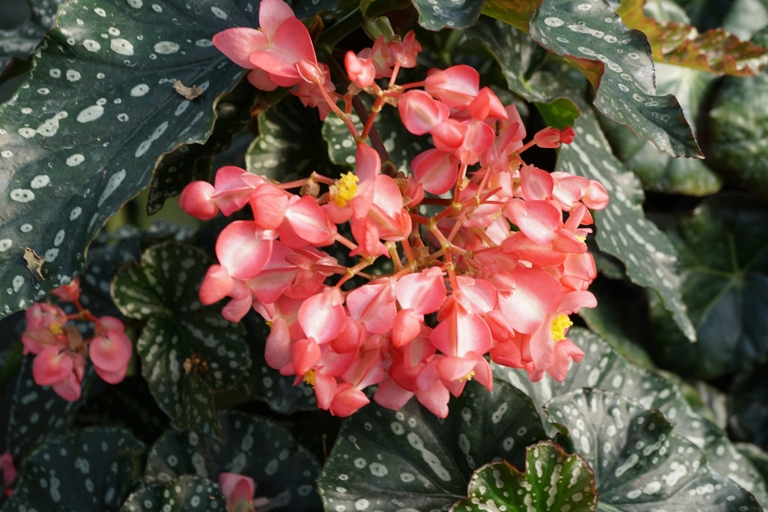
– Begonias need a lot of nutrients, so make sure you’re using a fertilizer that’s high in nitrogen.
– Begonias also like a lot of humidity, so misting the leaves regularly will help keep them healthy.
How To Cure Rhizoctonia Crown Rot
This fungal disease affects the plant’s roots, causing them to rot. If your begonias are dying, it’s likely due to rhizoctonia crown rot. The rot can spread to the stem and leaves, causing the plant to wilt and die.

To prevent rhizoctonia crown rot, water your begonias at the base of the plant, not from above. Be sure to water in the morning so the leaves have time to dry before nightfall. If you live in an area with high humidity, consider using a fungicide.
Cut away any rotting roots and replant the begonia in fresh, sterile potting mix. Be sure to water it carefully, keeping the leaves dry. You may also need to treat the plant with a fungicide. If your plant is already affected by rhizoctonia crown rot, you can try to save it by removing the affected leaves and stems.
Step One: Identify damaged parts of the plant
If your begonias are dying, the first step is to identify which parts of the plant are damaged. Once you’ve identified the problem areas, you can begin to troubleshoot the cause and find a solution. Look for brown or black leaves, wilted stems, and/or rotting roots.
In some cases, damaged begonias can be saved. But if the plant is too far gone, you may need to start from scratch. Either way, it’s important to identify the cause of the problem so you can avoid it in the future.
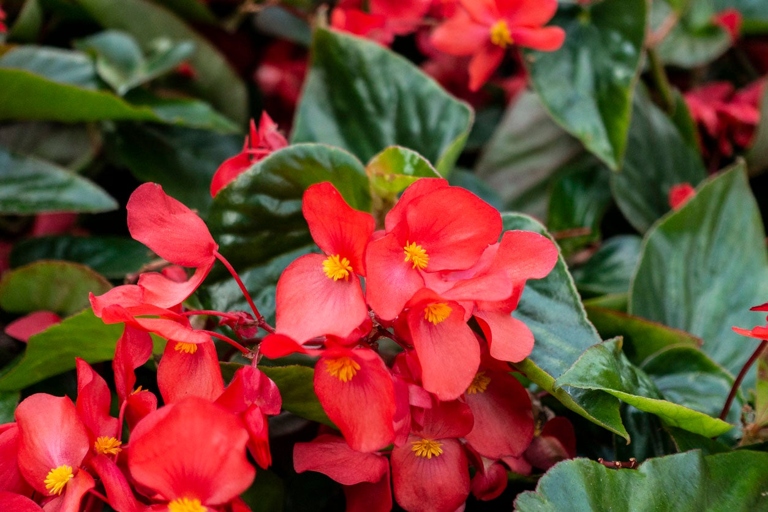
If you can’t figure out the cause, it’s best to consult with a professional. Some common causes include root rot, pests, and disease. There are many possible reasons why begonias might die. They will be able to help you diagnose the problem and find the best solution.
Step Two: Prune your Begonias
To prune your begonias, cut off any dead or dying leaves and stems. If your begonias are dying, the first step is to prune them. This will help them to grow back healthier and stronger. You can also cut back any leggy or overgrown stems. This will help to encourage new growth. Be sure to prune your begonias in the early spring, before they start to actively grow.
Step Three: Dig up Surrounding Soil
If the soil is dry at this depth, water it thoroughly. To prevent this, dig up the surrounding soil to a depth of about 8 inches. If the soil around your begonias is dry, it could be causing the plants to wilt and die.
Step Four: Apply Fungicides
Fungicides are chemicals that can kill fungi, and they come in both liquid and powder form. You can find them at your local garden center or online. If your begonias are dying, one possible solution is to apply fungicides.

You’ll need to apply them to the leaves of your begonias, as well as the stems and soil around the plants. With a little care, your begonias should start to look better in no time. When applying fungicides, be sure to follow the directions on the label carefully. Apply fungicides every two weeks or as needed, and be sure to water your begonias regularly.
Begonias Dying from Overwatering
If the leaves of your begonia are turning yellow and falling off, it’s a sign that you’re overwatering. Begonias are sensitive to too much water and will start to wilt and turn yellow if they’re getting too much. If your begonias are dying, it’s likely because you’re overwatering them. The best way to water begonias is to let the soil dry out in between waterings. To save your begonia, stop watering it so much and let the soil dry out.
How to Save Dying overwatered Begonias
Begonias are sensitive to too much water and will start to yellow and wilt if they’re getting too much. You can also try adding a drainage layer to the bottom of the pot. If the soil is still soggy, try repotting the begonias in a well-draining potting mix. Once the begonias are in a well-draining pot, water them only when the soil is dry to the touch. If your begonias are dying, it’s likely because they’re overwatered. To save your begonias, start by letting the soil dry out completely between waterings.
Step one: stop watering your Begonias
If your begonias are dying, the first step is to stop watering them. If you think you may be overwatering your begonias, allow the soil to dry out completely before watering again. Overwatering is one of the most common problems with begonias, and can lead to a number of problems including root rot, leaf spot, and stem rot. You should also check the drainage of your pots to make sure that water is not sitting in the bottom and causing the roots to rot.
Step two: Dry up the Soil
If the leaves of your plant begin to turn yellow or brown, this is a sign that the plant is suffering from drought stress. This may mean withholding water for a week or more, depending on the weather and the type of begonia you have. Overwatering can cause the soil to become waterlogged, which prevents the roots from getting the oxygen they need to thrive. The first step in solving this problem is to allow the soil to dry out completely. If you notice that your begonias are wilting, it may be due to too much water.
Step Three: Trim off the Rotten Roots
Using a sharp knife or pair of scissors, cut away the rotten roots, being careful not to damage the healthy roots. Once you’ve trimmed off the rotten roots, replant your begonia in fresh potting soil. If the roots of your begonia are black and mushy, it’s time to trim them off.
Step Four: Treat the Potting Soil
If the soil is too sandy, it won’t hold enough water and the begonias will dry out. If you’re still having trouble with your begonias not thriving, it might be the potting soil. The best potting soil for begonias is a mix of peat moss, perlite, and vermiculite. If the potting soil is too dense, it will hold too much water and begonias’ roots will rot. Begonias need well-drained, loose soil to grow in.

This will kill any bacteria or fungi that might be in the soil and harm the begonias. To do this, mix 1 part bleach with 9 parts water and soak the potting soil in the mixture for 30 minutes. When you’re repotting begonias or planting them in a new pot, treat the potting soil before adding it to the pot. Now the potting soil is ready to use. After 30 minutes, drain the potting soil and rinse it with clean water.
Step Five: Repot the Plant
If your begonia’s leaves are wilting or if the plant is overall looking unhealthy, it might be time to repot the plant. Here’s how to do it:
Choose a new pot that is about 2 inches wider than the current pot. 1.
Add fresh potting mix to the new pot. 2.

Gently remove the begonia from its current pot and loosen the roots. 3.
4. Place the begonia in the new pot and fill in around the roots with potting mix.
Water the plant well and place it in a location with bright, indirect light. 5.
Be sure to use a pot that is only slightly larger than the current pot, as begonias do not like to be rootbound. By repotting your begonia, you will give it the fresh start it needs to thrive.
Begonias Dying from Underwatering
If your begonias are dying, it’s likely due to underwatering. To avoid underwatering in the future, make sure to check the soil regularly and water when it’s dry to the touch. Begonias are sensitive to drought and will start to wilt and drop leaves when they’re thirsty. If you see these signs, water your begonias immediately and deeply.
Solution
Begonias like warm temperatures, but they can’t handle too much heat. Finally, check to see if the begonias are being attacked by pests. If the soil is too dry, the leaves will start to wilt. If the soil is too wet, the roots will rot. First, check to see if they are getting enough water. Begonias need to be kept moist, but not soggy. Second, check to see if they are getting enough light. Begonias need bright, indirect light. If your begonias are dying, there are a few potential solutions. Begonias need to be fertilized every two weeks during the growing season. Third, check to see if the temperature is too hot or too cold. If they are not getting enough nutrients, the leaves will start to turn yellow or brown. Begonias are susceptible to aphids, mealybugs, and whiteflies. Fourth, check to see if the begonias are getting enough nutrients. If you see any of these pests on your begonias, you’ll need to treat them with an insecticide. If they are getting too much sun, the leaves will start to turn yellow or brown. If the temperature is too cold, the leaves will start to turn brown and drop off.
Lack of Nutrients
There are a few things you can do to try and remedy the situation. If your begonias are dying, it could be due to a lack of nutrients. This is a common problem with begonias, as they are notorious for being finicky eaters.
First, make sure you are fertilizing your begonias regularly. They need a steady supply of nutrients to stay healthy, so if you’re not fertilizing them regularly, they could be starving.
You can buy a soil test kit at your local nursery or garden center to test the pH of your soil. Begonias prefer slightly acidic soil, so if your soil is too alkaline, it could be preventing them from getting the nutrients they need. Second, check the pH of your soil.
They like to be kept moist, but not soggy. If you’re overwatering them, it could be causing their roots to rot, which would prevent them from getting the nutrients they need. Finally, make sure you are watering your begonias properly.

If you’re still having trouble getting your begonias to thrive, it’s best to consult with a local nursery or garden center. They can help you figure out what’s going wrong and how to fix it.
Solution
If your begonias are dying, it could be for a number of reasons. Here are some signs to look for, as well as some solutions:
Move your plant to a spot that gets less direct sunlight. If the leaves of your begonia are yellowing, it could be a sign of too much sun exposure.
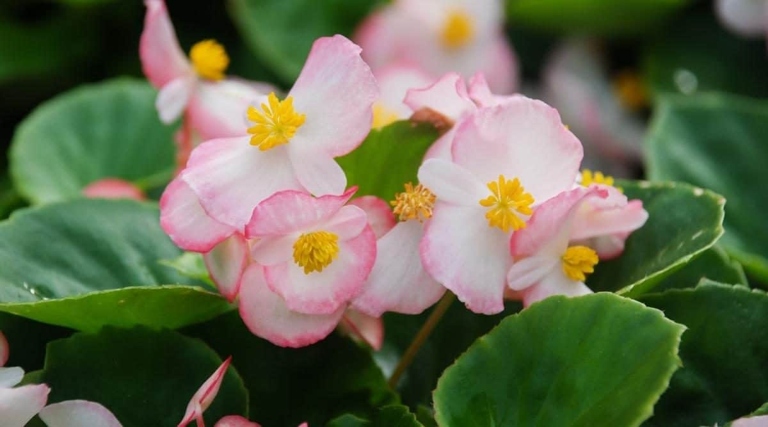
If the leaves of your begonia are browning, it could be a sign of too little sun exposure. Move your plant to a spot that gets more direct sunlight.
If the leaves of your begonia are wilting, it could be a sign of too much water. Allow the soil to dry out completely before watering again.
Water your plant more frequently. If the leaves of your begonia are drooping, it could be a sign of too little water.
If you see any pests on your begonia, such as aphids, mealybugs, or whiteflies, treat them with an appropriate insecticide.
With a little troubleshooting, you should be able to figure out what’s causing your begonias to die and take steps to fix the problem.
Incorrect Soil pH
The ideal pH for begonias is between 6.0 and 7.0. You can test the pH of your soil with a pH test kit. If your begonias are dying, it could be because of incorrect soil pH. If the pH is too high, the begonias will be unable to absorb water from the soil. If the pH is not in the ideal range, you can adjust it by adding lime to raise the pH or sulfur to lower the pH. If the pH is too low, the begonias will not be able to absorb nutrients from the soil.
Solution
If your begonias are dying, it could be for a number of reasons. Here are some signs to look for, as well as some solutions.
If the leaves of your begonias are wilting, that’s a sign that they need more water. Begonias need to be watered regularly, especially during hot weather. One reason your begonias may be dying is because they are not getting enough water.
If your begonias are in a dark spot, they may start to die. Begonias need bright, indirect light to thrive. Another reason your begonias may be dying is because they are not getting enough light.

If your begonias are dying, try moving them to a spot with more light and water them more regularly. With a little TLC, your begonias should start to thrive again.
Begonia Dying Due to Pest Infestation
The most common pests that attack begonias are aphids, mealybugs, and whiteflies. If your begonias are dying, it’s likely due to a pest infestation. These pests suck the sap out of the plant, causing it to wilt and die.
If the infestation is severe, you may need to treat the plant multiple times. To get rid of pests, start by spraying the plant with water to knock them off. Then, apply an insecticide designed for use on begonias. Be sure to follow the instructions on the label.

Start by planting them in well-drained soil and keeping them watered. You can also take steps to prevent pests from attacking your begonias in the first place. Additionally, avoid using chemicals on the plants that could attract pests.
Solution
If your begonias are dying, it could be for a number of reasons. Here are some possible solutions:
Check the soil moisture. Begonias need to be kept moist, but not soggy. 1. Allow the top inch of soil to dry out before watering again.
Check for pests. If you see any pests on your plant, treat them immediately. Begonias are susceptible to a number of pests, including aphids, mealybugs, and whiteflies. 2.
If they are getting too much sun, they will start to wilt. Move them to a shadier spot. Begonias need bright, indirect light. 3. Check the light.
Begonias prefer warm temperatures, around 70 degrees Fahrenheit. 4. Check the temperature. If it gets too cold, they will start to die back. Move them to a warmer spot.
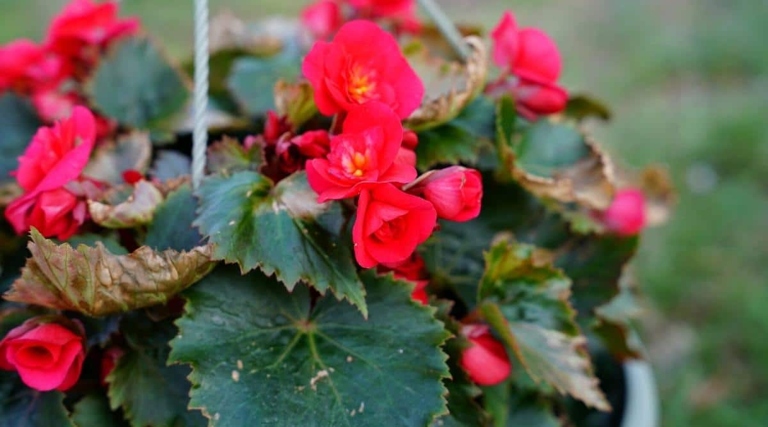
Begonias need to be fertilized every two weeks. Use a balanced fertilizer and follow the directions on the package. Check the fertilizer. 5.
Too Much Sun Exposure
Here are a few signs that your plant is getting too much sun: If your begonias are dying, it’s likely because they’re getting too much sun exposure.
The leaves are turning yellow or brown.
The leaves are wilting.

The flowers are fading.
If you see any of these signs, move your plant to a spot that gets less sun. You may also need to water it more often, as sun exposure can cause the soil to dry out quickly.
How to Revive SunBurnt Begonias
With a little TLC, they can soon be looking as good as new. If your begonias are looking a little worse for wear after a long summer in the sun, don’t despair! Here’s what to do:
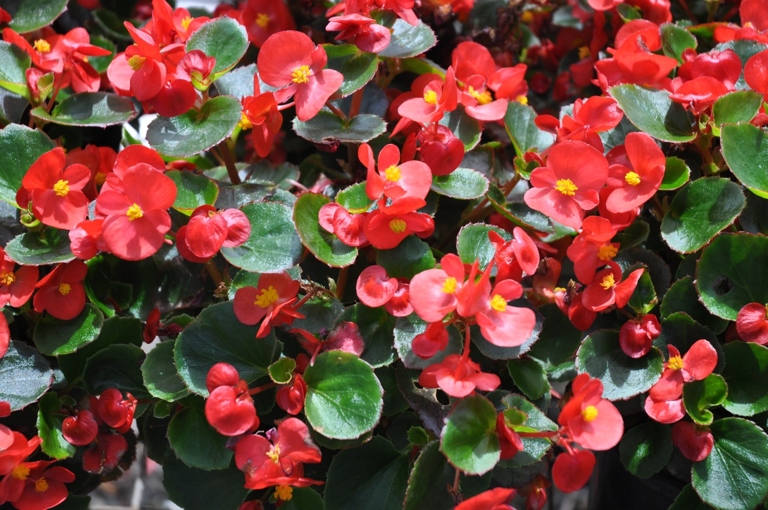
This will help them to regrow with fresh, green leaves. 1. Cut back the plants. Begonias can tolerate a fair amount of pruning, so don’t be afraid to cut them back by a third or even half.
Water well. If possible, use rainwater or filtered water, as begonias are sensitive to chemicals in tap water. Begonias like to be kept moist, so make sure to water them deeply and regularly. 2.
After a long period in the sun, your begonias will appreciate a little time in the shade. 3. Give them some shade. Move them to a shady spot in the garden or put them on a windowsill out of direct sunlight.
With a little care, your sunburnt begonias will soon be looking as good as new!
Step One: Keep it Away from the Scorching Light
Begonias need bright, indirect light to thrive, so if you’re keeping them in a sunny spot, move them to a shadier location. If they’re already in a shady spot, try moving them to a spot that gets a few hours of morning sun. If your begonias are wilting and the leaves are turning yellow, it’s likely that they’re getting too much sun.
If you can’t provide afternoon shade, try misting your begonias regularly to help cool them down. If you live in a hot climate, your begonias will do best in a spot that gets afternoon shade.

If you’re not sure whether your begonias are getting too much sun or not enough, check the leaves for scorch marks. If the leaves are brown and crispy, they’ve been damaged by too much sun.
Step Two: Place it in the Right Location
If you live in an area with a lot of sun, it’s important to find a spot for your begonias that gets some shade during the day. One of the most important steps in keeping your begonias healthy is to make sure you place them in the right location. Begonias can also tolerate a fair amount of shade, so if you live in an area with less sun, you’ll want to find a spot that gets some sun during the day.

If you’re not sure if your soil is well-drained, you can always test it by digging a small hole and filling it with water. If the water takes longer than a few hours to drain, you may need to amend your soil with some sand or organic matter to improve drainage. If the water drains away within a few hours, your soil is well-drained. Begonias do not like to sit in wet soil, so make sure you plant them in an area that has well-drained soil. It’s also important to make sure your begonias have good drainage.
Not Enough Sunlight
If you live in an area with long winters and short days, you may need to supplement your begonias’ sunlight with grow lights. Begonias need at least six hours of sunlight each day, so if they’re not getting that, they’ll start to wilt and die. If your begonias are dying, it could be because they’re not getting enough sunlight.

If you think your begonias aren’t getting enough sunlight, the first thing to do is move them to a sunnier spot. If that doesn’t help, try giving them a boost with grow lights. Grow lights are special lights that mimic sunlight and can help your begonias get the light they need to thrive.
Solution
Begonias need to be watered regularly, but not too much. Make sure to keep them away from windows, doors, and vents where they might be exposed to cold or hot air. If your begonias are dying, there are a few potential causes and solutions. Finally, begonias need bright, indirect light. Move them to a brighter spot and see if that helps. One common issue is that begonias are sensitive to drafts. Another problem could be that they’re not getting enough water. If they’re not getting enough light, they will become leggy and weak. Allow the top inch of soil to dry out before watering again.
Begonias Dying in Cold Temperatures
The last reason could be that the plant is not getting enough nutrients. Begonias need a lot of light to thrive, so if they are not getting enough, they may start to die. One reason could be that the plant is not getting enough light. Begonias need to be fertilized regularly to stay healthy, so if they are not getting enough nutrients, they may start to die. Another reason could be that the plant is not getting enough water. There are a few reasons why begonias may be dying in cold temperatures. Begonias need to be kept moist, but not too wet, so if they are not getting enough water, they may start to die.

If you think your begonia is dying because of one of these reasons, there are a few things you can do to try to save it. If it is not, try moving it to a brighter spot. First, make sure that the plant is getting enough light. If it is not, try watering it more often. If it is not, try fertilizing it more often. Third, make sure that the plant is getting enough nutrients. Second, make sure that the plant is getting enough water.
How to Revive Begonias from Cold Injury
Here are some tips on how to revive them: If your begonias are dying, it may be due to cold injury.
1. Remove the plant from the cold environment and bring it indoors.
Inspect the plant for damage and cut away any damaged leaves or stems. 2.
Place the plant in a warm, sunny location and water it regularly. 3.

4. Once the plant has recovered, you can replant it outdoors.
Begonias Dying after Repotting
Begonias are sensitive to changes in their surroundings, and they need time to acclimate to new conditions. If your begonias are dying after you repot them, it’s likely due to one of several reasons. Begonias prefer a well-drained, slightly acidic mix. This can happen if you were too rough when handling the plant, or if the roots were left exposed to the air for too long. If the mix you used was too heavy or too alkaline, it could have caused the plant to die. Finally, it’s possible that the potting mix you used was not ideal for begonias. The most common is that the roots were damaged during the repotting process. Another possibility is that the plant was not given enough time to adjust to its new environment before being repotted again.
Solution
There are several potential causes of death in begonias, including pests, disease, and improper care. If your begonias are dying, it’s important to figure out the cause so you can take steps to remedy the situation.

If you see any pests on your begonias, be sure to remove them immediately and treat the plant with an insecticide. These pests can suck the sap out of the plant, causing it to wilt and die. Begonias are particularly susceptible to aphids, mealybugs, and whiteflies. One of the most common causes of death in begonias is pests.
Begonias are susceptible to a variety of diseases, including root rot, powdery mildew, and leaf spot. Disease is another common cause of death in begonias. If you notice any of these diseases on your begonias, be sure to treat them immediately with a fungicide.
Improper care is another common cause of death in begonias. Begonias also need well-draining soil, so be sure to use a pot with drainage holes and add some sand or gravel to the bottom to help with drainage. Begonias need a lot of sunlight and water to thrive, so be sure to place them in a sunny spot and water them regularly. If you follow these care tips, your begonias should be healthy and happy.
How to safely un-pot and dispose of your Begonias suffering from Pythium Rot or Rhizoctonia Crown Rot
If your begonias are dying, it’s important to figure out the cause so you can take steps to prevent it from happening again. Both of these diseases are caused by fungi that thrive in wet, humid conditions. Two of the most common diseases that affect begonias are Pythium rot and Rhizoctonia crown rot.
To safely un-pot and dispose of your begonias suffering from Pythium rot or Rhizoctonia crown rot, follow these steps:
Wear gloves and a mask to protect yourself from the fungi. 1.

Carefully remove the plant from its pot. 2.
3. Cut away any diseased roots or stem tissue.
Dispose of the plant and all of its potting material in a plastic bag. 4.
Wash your hands and tools thoroughly with soap and water. 5.
By following these steps, you can help prevent the spread of these diseases and keep your begonias healthy.
Step One: Cut the Extended Roots below the Pot
When repotting a begonia, it is important to cut the extended roots below the pot. This will help the plant to better absorb water and nutrients. If the roots are left too long, they can become tangled and cause the plant to suffocate.
Step Two: Safely Up-Root your Begonias
This will allow you to inspect the roots for signs of disease or damage. If your begonias are dying, the first step is to safely up-root them.
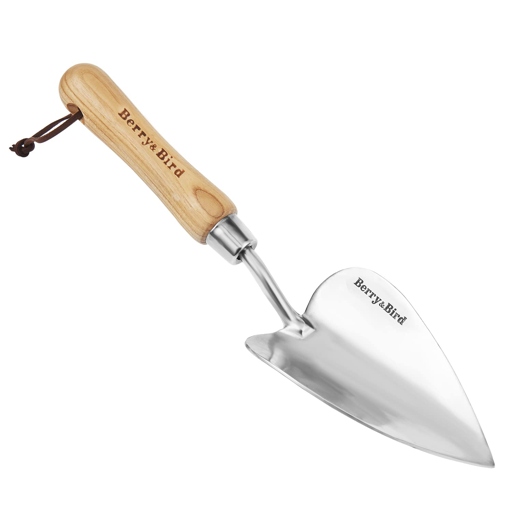
Then, gently lift the plant out of the ground, being careful not to damage the roots. To up-root your begonias, first loosen the soil around the plant with a spade or trowel.
Once the plant is out of the ground, inspect the roots for signs of disease or damage. If you see any, cut away the affected roots with a sharp knife.
Water well and keep the plant in a warm, sunny location. Once you have inspected and trimmed the roots, replant the begonia in fresh, well-drained soil. With proper care, your begonias should soon recover and start to thrive.
Step Three: Dig Around the Plant
This will help you determine if the roots are healthy and if the plant is getting the proper amount of water. If the plant is not getting enough water, you will need to water it more frequently. If your begonias are dying, the third step is to dig around the plant. If the roots are unhealthy, you may need to replant the begonia.
Step four: Sterilize your Tools
You can also use a commercial disinfectant, but be sure to follow the instructions on the label. Over time, gardening tools can accumulate dirt, bacteria, and other harmful organisms that can infect your plants. After sterilizing your tools, be sure to rinse them thoroughly with clean water before using them on your begonias. To sterilize your tools, soak them in a solution of one part bleach to nine parts water for at least 30 minutes. If you’re still having trouble with your begonias after following the first three steps, it’s time to check your tools.
How Not to Kill Your Begonias?
If your begonias are dying, it’s important to figure out why so you can take steps to save them. There are several possible reasons for begonia death, including overwatering, underwatering, too much sun, not enough sun, and pests.
If you think you may be overwatering your begonias, allow the soil to dry out completely before watering again. Overwatering is a common cause of begonia death. Begonias need well-drained soil and should be watered only when the soil is dry to the touch.

If the leaves of your begonias start to droop, that’s a sign that they need more water. These plants need to be kept moist, but not soggy. Underwatering can also kill begonias.
If your begonias are getting too much sun, move them to a shadier spot. Too much sun can scorch begonia leaves and cause them to turn brown.
If your begonias are not getting enough light, they may become leggy and produce fewer flowers. Not enough sun can also be a problem. Begonias need bright, indirect light to thrive.
Pests can also kill begonias. Aphids, mealybugs, and whiteflies are all common begonia pests. If you see pests on your begonias, treat them with an insecticidal soap or neem oil.
Frequently Asked Questions
1. Why are my begonias dying?
There are several possible reasons for why your begonias may be dying. It could be due to a lack of sunlight, too much water, or pests.
2. What are the signs that my begonias are dying?
The leaves of your begonias may turn yellow or brown, and the stems may become weak. The flowers may also start to wilt.
3. What can I do to save my begonias?
If you think that your begonias are dying due to a lack of sunlight, try moving them to a sunnier location. If they are getting too much water, let the soil dry out between watering. And if you think pests are the problem, try using an insecticide.
4. Why are my begonias not blooming?
There are several possible reasons for why your begonias may not be blooming. It could be due to a lack of sunlight, too much water, or pests.
5. What can I do to get my begonias to bloom?
If you think that your begonias are not blooming due to a lack of sunlight, try moving them to a sunnier location. If they are getting too much water, let the soil dry out between watering. And if you think pests are the problem, try using an insecticide.
Final thoughts
If your begonias are dying, it could be for a number of reasons. The most common reason is that they are not getting enough water. Begonias need to be watered regularly, especially during hot weather. Another possible reason is that they are not getting enough light. Begonias need at least four hours of sunlight a day. If they are not getting enough light, they will start to stretch and become leggy. Another possible reason for dying begonias is too much fertilizer. Begonias should be fertilized every two weeks during the growing season. If you are using too much fertilizer, it can burn the roots and kill the plant.
